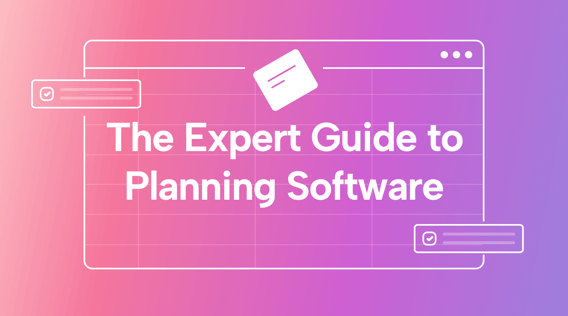We’ve all heard the phrase: “Proper planning prevents poor performance.” In today's fast-paced world, the ability to plan efficiently and strategically is crucial to organizing personal tasks, managing complex projects, and optimizing business operations. However, manual planning methods often fall short in meeting the demands of modern-day planning challenges. That's where planning software emerges as a game-changer.
In this article, we delve into the definition of planning software, the benefits of incorporating planning software into your operations, the core features of a great planning software, and why Motion is one of the top-rated planning software available in 2023.
What is planning software?
Planning software, also known as project management tools, helps individuals, teams, and organizations in creating, managing, and optimizing plans. It provides a digital platform where users can outline objectives, allocate resources, schedule tasks, track progress, and make informed decisions related to their planning activities.
Project planning software helps project managers streamline workflows, improve communication, manage remote teams, and ensure projects are completed on time and within budget. It offers features such as task management, timeline visualization, resource allocation, budgeting, and integration capabilities with other software systems.
Planning software is utilized across various industries and sectors, including construction, IT, manufacturing, marketing, and healthcare. For more information about project management, read our article on the ultimate project planning guide for successful projects.
Benefits of using planning software
 |
Planning software offers numerous benefits that significantly enhance productivity and organization in various domains. Here are some key advantages of incorporating planning software into your workflow or business.
1. Enhanced efficiency
Planning software automates repetitive daily tasks, reduces manual errors, and accelerates the planning process across project teams. By streamlining workflows, it allows individuals and teams to allocate their time and resources more effectively, resulting in increased productivity and speedy achievement of project goals.
66% of tech leaders claim that they’ve been very effective using digital to advance their business strategy, and 99% of executives have generated returns from digital investments.
2. Centralized information
Planning software provides a centralized platform where all project-related information is stored. This includes project goals, project schedules, documents, and communications. With a centralized repository, team members have easy access to up-to-date information, eliminating the need for searching through multiple sources or relying on outdated documents.
This fosters better collaboration and task dependencies, as team members can quickly locate the information they need, ensuring everyone is aligned and working towards common goals.
3. Improved collaboration
Planning software serves as a hub for collaboration among team members, regardless of their location. It offers features such as real-time document sharing, task assignment, discussion features, and notifications. These features facilitate effective communication and promote seamless collaboration.
Team members can work together on tasks, provide feedback, and have real-time discussions within the software itself. By enabling efficient collaboration, planning software allows for the exchange of ideas, encourages transparency, and helps to build a culture of teamwork and accountability.
4. Real-time monitoring and reporting
Planning software allows for real-time updates and monitoring of project progress, providing instant visibility into task completion, milestones, and potential bottlenecks. With customizable reporting features, managers get project insights, generate comprehensive reports tracking key metrics, and make data-driven decisions promptly.
5. Time and cost savings
Planning software helps optimize resource allocation by ensuring tasks are assigned appropriately and deadlines are met. Facilitating efficient task management minimizes the risk of delays and bottlenecks, resulting in improved project timelines.
Furthermore, automated features such as reminders, notifications, and task dependencies reduce the need for manual follow-ups and coordination, saving time and effort. Effective time management and streamlined workflows contribute to cost savings by minimizing project overruns and reducing the need for rework.
6. Risk management
Planning software plays a crucial role in identifying and mitigating project risks. It allows users to assess potential risks, plan for contingencies, and implement preventive measures. Advanced features like risk tracking and mitigation enable project managers to prioritize and address risks effectively, reducing the likelihood of project delays or failures. The ability to proactively manage risks ensures that projects stay on track, deadlines are met, and project outcomes are successful.
Core features of a great planning software
 |
Before selecting a planning software, it's important to consider several key factors to ensure that the software aligns with your specific needs and requirements. Here are some notable features to consider.
1. Wide range of features and functionalities
While there are several popular project management software, you need to assess the list of features offered by the software in relation to the specific purpose for which you need it. It’s also important to look for essential capabilities such as task management scheduling, capacity planning, collaboration tools, reporting and analytics, and integration with other software. Consider which features are indispensable to your workflow and goals, and ensure your selected software provides them.
Motion sets the standard for features and functionality in planning software, offering a comprehensive suite of AI-powered tools that empower users to effectively plan, manage, and execute critical tasks. With its extensive range of powerful features, Motion covers all aspects of project management, including robust task management, calendar management, time tracking, and budget management. By providing essential tools within a single platform, Motion eliminates the need for additional software, streamlining project management processes and enhancing productivity.
2. Easy-to-use interface
One of the key features of planning software is a user-friendly interface that allows users to easily navigate and utilize the various functionalities. It should have a well-designed layout, intuitive controls, and clear instructions. The software should be easy to understand and operate, minimizing the learning curve for new users and maximizing productivity.
Motion prioritizes a seamless user experience with its intuitive and visually appealing interface. Its drag-and-drop functionality also allows for quick scheduling, automatically adjusting tasks to fit neatly into the calendar. Motion's focus on usability ensures that users can maximize productivity and complete projects on time rather than grappling with complex software.
3. Extensive integration capabilities
Planning software should offer integration capabilities to seamlessly connect with other tools and software that are essential to your workflow. This includes integration with project management systems, CRM software, document management tools, and other relevant applications. Integration allows for the smooth transfer of data and information, eliminates manual data entry, and improves overall efficiency.
 |
Motion understands the importance of seamless connectivity and provides robust integration with your favorite tools. It seamlessly integrates with popular platforms such as calendars, email clients, and document management systems. This integration streamlines workflows by eliminating the need for manual data entry, ensuring data consistency across platforms, and enabling efficient collaboration. Motion's integration capabilities allow users to work with their preferred tools while benefiting from the comprehensive project management features it offers.
4. Collaboration and communication tools
Effective planning software should provide team collaboration features that enable teams to work together efficiently. This includes features such as real-time collaboration, task assignment and tracking, file management, and comment or feedback mechanisms. It should also have communication tools like instant messaging and the ability to comment on tasks to facilitate effective communication among team members.
Collaboration lies at the heart of successful project management, and Motion recognizes its significance. The software offers a range of collaboration and communication tools, including file sharing, discussions, comments, and notifications. These features foster effective teamwork, encourage real-time communication, and enhance collaboration among project stakeholders. By providing a centralized hub for collaboration, Motion ensures that team members are aligned, information is shared seamlessly, and project progress is communicated efficiently.
5. Cost-friendly
Consider the cost of the planning software and evaluate whether it provides good value for money. This involves assessing the features and functionalities offered in relation to the price. Additionally, consider factors such as scalability, ongoing maintenance and support costs, and the potential for future upgrades. It's important to strike a balance between the software's capabilities and its affordability to ensure it aligns with your budget and long-term goals.
 |
Motion provides excellent value for money with its comprehensive features and affordable pricing options. It offers flexible plans to suit the needs of different businesses and organizations, whether they are small teams or large enterprises. The software's pricing options start with a basic plan at $34/month for individuals and $20/user/month for teams, with huge discounts when billed annually. They also offer a free 7-day trial for both plans.
6. Task Management tools
Planning software enables the creation, assignment, and tracking of tasks. Users can set deadlines, assign responsibilities to team members, and monitor resource capacity. Here’s our article on the 5 best task management software of 2023.
Motion sets itself apart with its powerful and intuitive AI task management features. Users can effortlessly create tasks, plan projects, and track progress, all within a user-friendly interface. Motion's task management functionality ensures that projects stay on track and team members stay organized, leading to improved efficiency and timely project completion. Its algorithmic AI automatically helps you plan your schedule based on preselected criteria. This allows users of Motion to save up to 2 hours daily.
7. Time Tracking features
Time tracking features enable users to record the time spent on tasks. This helps in tracking progress, evaluating resource utilization, and generating accurate reports.
Motion's project tracking feature enables users to accurately monitor the time spent on tasks and projects. With built-in timers, internal teams can effortlessly track and record their work hours. Motion's time-tracking capability allows for accurate project progress monitoring, resource allocation optimization, and precise billing and invoicing, resulting in enhanced project efficiency and cost control.
8. Customization options
Planning software often allows for customization to adapt to different project management methodologies, workflows, and specific industry requirements. It provides flexibility in configuring project dashboards, adding custom fields, and tailoring the software to the organization's needs.
Motion offers extensive customization options, allowing users to configure settings, add custom fields, and tailor the software to match their unique workflows and processes. Whether it's creating custom project templates, defining specific task attributes, or designing personalized reports, Motion provides the flexibility to accommodate diverse project requirements. This level of customization empowers users to work in a way that best suits their projects and organizational needs, ensuring optimal project management efficiency and effectiveness.
9. Advanced reporting and analytics tools
Advanced reporting and analytics tools are a crucial component of modern planning software, offering organizations the ability to harness the power of data and gain valuable insights for informed decision-making.
 |
Motion empowers users with its advanced reporting and analytics functionalities. Users can generate comprehensive reports, charts, and dashboards that provide valuable insights into project progress, resource utilization, budget tracking, and overall performance. With data-driven insights at their fingertips, users can make informed decisions, identify bottlenecks, and optimize project execution for better outcomes.
10. Scalability
In the realm of project management, organizations experience fluctuations in project sizes and complexities as they evolve and expand. Using scalable planning software empowers users to seamlessly adapt and accommodate these changes without disruptions. Scalability enables the software to handle projects of various magnitudes, from small teams with simple workflows to large enterprises with multiple intricate projects. By providing the flexibility to scale up or down, planning software ensures that project management processes remain efficient and effective regardless of the organization's size or project portfolio.
Motion is built to accommodate projects of all sizes, from small teams to large enterprises. The software scales seamlessly, allowing organizations to expand their project management capabilities as their needs grow. Whether it's managing multiple projects simultaneously or handling complex project structures, Motion provides the scalability required to support diverse project portfolios.
You can also read our in-depth guide on the best planner apps of 2023 to choose the best option for your business.
Empowering Project Management with Planning Software
Planning software has revolutionized the way individuals and organizations approach their operations, bringing efficiency, collaboration, and productivity to new heights. Moreover, planning software serves as a centralized hub for information, enabling stakeholders to make data-driven decisions and drive project success.
To experience the next level of AI-assisted planning and scheduling, we invite you to try out Motion for free. With its advanced features and intuitive interface, Motion automatically schedules your tasks and meetings and helps you streamline your workflows. Get started today.





